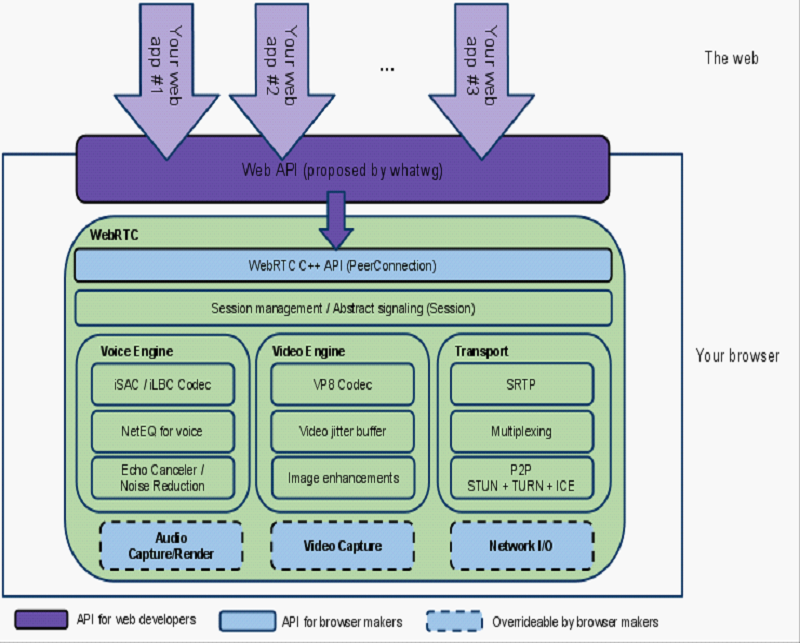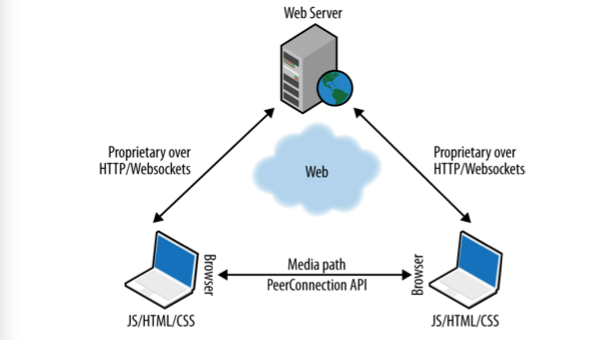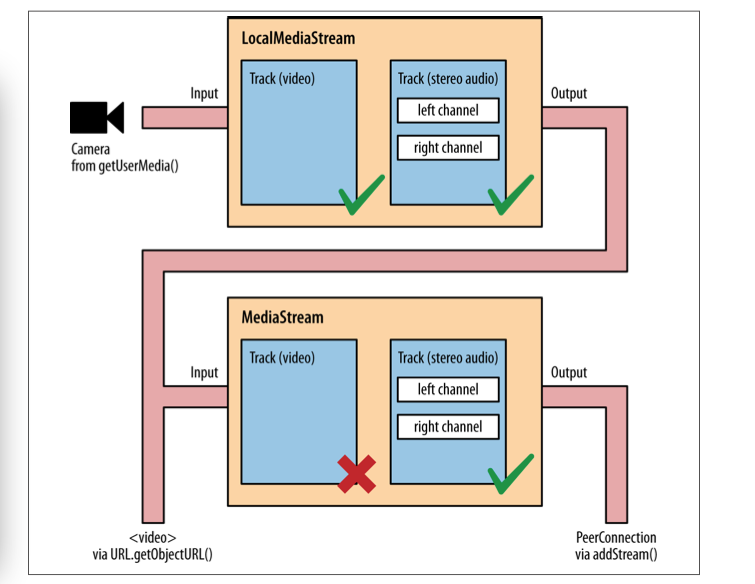前面写的一系列总结都是讲webrtc如何下载,编译,开发的,有些人可能有点云里雾里了,WEBRTC不是用来搞跨浏览器开发的吗,怎么我讲的这些跟浏览器扯不上任何关系,其实看看下面这个架构图,你就明白了
如果你只想做基于浏览器的视频通话功能,上面这些你可以不理解,更不需要去下载编译WEBRTC代码,因为实现这些功能所需要的JS接口浏览器已经帮你实现了,你只需要简单调用即可,我们先看看实现下面这样一个功能主要涉及哪些步骤?
2,获取本地视频流:navigator.getUserMedia(constraints, successCallback, errorCallback);
对应到手机端就是webrtc编译成功后的appRTCDemo.apk.

如果你只想做基于浏览器的视频通话功能,上面这些你可以不理解,更不需要去下载编译WEBRTC代码,因为实现这些功能所需要的JS接口浏览器已经帮你实现了,你只需要简单调用即可,我们先看看实现下面这样一个功能主要涉及哪些步骤?

2,获取本地视频流:navigator.getUserMedia(constraints, successCallback, errorCallback);
navigator.getUserMedia = navigator.getUserMedia ||
navigator.webkitGetUserMedia || navigator.mozGetUserMedia;
// Callback to be called in case of success...
function successCallback(gotStream) {
video.src = window.URL.createObjectURL(stream);
// Start playing video
video.play();
}
// Callback to be called in case of failure...
function errorCallback(error){ console.log("navigator.getUserMedia error: ", error);
}
// Constraints object for low resolution video
var qvgaConstraints = { video: {
mandatory: {
maxWidth: 320,
maxHeight: 240
} }
};
// Constraints object for standard resolution video
var vgaConstraints = { video: {
mandatory: {
maxWidth: 640,
maxHeight: 480
} }
};
// Constraints object for high resolution video
var hdConstraints = { video: {
mandatory: {
minWidth: 1280,
minHeight: 960
} }
};
function getMedia(constraints){
if (!!stream) { video.src = null; stream.stop();
}
navigator.getUserMedia(constraints, successCallback, errorCallback);
}
3,SDP协商:createOffer,createAnswer.
localPeerConnection.createOffer(gotLocalDescription, onSignalingError);
// Handler to be called when the 'local' SDP becomes available
function gotLocalDescription(description){
// Add the local description to the local PeerConnection
localPeerConnection.setLocalDescription(description);
log("Offer from localPeerConnection: \n" + description.sdp);
// ...do the same with the 'pseudoremote' PeerConnection
// Note: this is the part that will have to be changed if you want // the communicating peers to become remote
// (which calls for the setup of a proper signaling channel) remotePeerConnection.setRemoteDescription(description);
// Create the Answer to the received Offer based on the 'local' description
remotePeerConnection.createAnswer(gotRemoteDescription, onSignalingError);
}
// Handler to be called when the remote SDP becomes available
function gotRemoteDescription(description){
// Set the remote description as the local description of the
// remote PeerConnection.
remotePeerConnection.setLocalDescription(description);
log("Answer from remotePeerConnection: \n" + description.sdp);
// Conversely, set the remote description as the remote description of the // local PeerConnection
localPeerConnection.setRemoteDescription(description);
}
4,ICE协商:
// Add a handler associated with ICE protocol events
localPeerConnection.onicecandidate = gotLocalIceCandidate;
remotePeerConnection.onicecandidate = gotRemoteIceCandidate;
// Handler to be called whenever a new local ICE candidate becomes available
function gotLocalIceCandidate(event){ if (event.candidate) {
// Add candidate to the remote PeerConnection
remotePeerConnection.addIceCandidate(new RTCIceCandidate(event.candidate));
log("Local ICE candidate: \n" + event.candidate.candidate);
}
}
// Handler to be called whenever a new remote ICE candidate becomes available
function gotRemoteIceCandidate(event){ if (event.candidate) {
// Add candidate to the local PeerConnection
localPeerConnection.addIceCandidate(new RTCIceCandidate(event.candidate));
log("Remote ICE candidate: \n " + event.candidate.candidate);
}
}
5,使用RTCPeerConnection对象在浏览器之间交换媒体流数据. 
function call() {
log("Starting call");
// Note well: getVideoTracks() and getAudioTracks() are not currently supported in Firefox...
// ...just use them with Chrome
if (navigator.webkitGetUserMedia) {
// Log info about video and audio device in use
if (localStream.getVideoTracks().length > 0) {
log('Using video device: ' + localStream.getVideoTracks()[0].label);
}
if (localStream.getAudioTracks().length > 0) {
log('Using audio device: ' + localStream.getAudioTracks()[0].label);
}
}
// Chrome
if (navigator.webkitGetUserMedia) {
RTCPeerConnection = webkitRTCPeerConnection;
// Firefox
}else if(navigator.mozGetUserMedia){
RTCPeerConnection = mozRTCPeerConnection;
RTCSessionDescription = mozRTCSessionDescription;
RTCIceCandidate = mozRTCIceCandidate;
}
log("RTCPeerConnection object: " + RTCPeerConnection);
// This is an optional configuration string, associated with NAT traversal setup
var servers = null;
// Create the local PeerConnection object
localPeerConnection = new RTCPeerConnection(servers);
log("Created local peer connection object localPeerConnection");
// Add a handler associated with ICE protocol events
localPeerConnection.onicecandidate = gotLocalIceCandidate;
// Create the remote PeerConnection object
remotePeerConnection = new RTCPeerConnection(servers);
log("Created remote peer connection object remotePeerConnection");
// Add a handler associated with ICE protocol events...
remotePeerConnection.onicecandidate = gotRemoteIceCandidate;
// ...and a second handler to be activated as soon as the remote stream becomes available
remotePeerConnection.onaddstream = gotRemoteStream;
// Add the local stream (as returned by getUserMedia() to the local PeerConnection
localPeerConnection.addStream(localStream);
log("Added localStream to localPeerConnection");
// We're all set! Create an Offer to be 'sent' to the callee as soon as the local SDP is ready
localPeerConnection.createOffer(gotLocalDescription, onSignalingError);
}
function onSignalingError(error) {
console.log('Failed to create signaling message : ' + error.name);
}
// Handler to be called when the 'local' SDP becomes available
function gotLocalDescription(description){
// Add the local description to the local PeerConnection
localPeerConnection.setLocalDescription(description);
log("Offer from localPeerConnection: \n" + description.sdp);
// ...do the same with the 'pseudo-remote' PeerConnection
// Note well: this is the part that will have to be changed if you want the communicating peers to become
// remote (which calls for the setup of a proper signaling channel)
remotePeerConnection.setRemoteDescription(description);
// Create the Answer to the received Offer based on the 'local' description
remotePeerConnection.createAnswer(gotRemoteDescription, onSignalingError);
}
// Handler to be called when the 'remote' SDP becomes available
function gotRemoteDescription(description){
// Set the 'remote' description as the local description of the remote PeerConnection
remotePeerConnection.setLocalDescription(description);
log("Answer from remotePeerConnection: \n" + description.sdp);
// Conversely, set the 'remote' description as the remote description of the local PeerConnection
localPeerConnection.setRemoteDescription(description);
}
// Handler to be called as soon as the remote stream becomes available
function gotRemoteStream(event){
// Associate the remote video element with the retrieved stream
if (window.URL) {
// Chrome
remoteVideo.src = window.URL.createObjectURL(event.stream);
} else {
// Firefox
remoteVideo.src = event.stream;
}
log("Received remote stream");
}
// Handler to be called whenever a new local ICE candidate becomes available
function gotLocalIceCandidate(event){
if (event.candidate) {
// Add candidate to the remote PeerConnection
remotePeerConnection.addIceCandidate(new RTCIceCandidate(event.candidate));
log("Local ICE candidate: \n" + event.candidate.candidate);
}
}
// Handler to be called whenever a new 'remote' ICE candidate becomes available
function gotRemoteIceCandidate(event){
if (event.candidate) {
// Add candidate to the local PeerConnection
localPeerConnection.addIceCandidate(new RTCIceCandidate(event.candidate));
log("Remote ICE candidate: \n " + event.candidate.candidate);
}
上面基本上就是浏览器上视频通话涉及的主要对象.对应到手机端就是webrtc编译成功后的appRTCDemo.apk.
收藏的用户(0) X
正在加载信息~
推荐阅读
最新回复 (0)
站点信息
- 文章2305
- 用户1336
- 访客11335148
每日一句
Life is more about giving than taking.
人生重在给予,而非索取。
人生重在给予,而非索取。
 VirtualXposed,让你无需Root也能使用Xposed框架!
VirtualXposed,让你无需Root也能使用Xposed框架! macOS系统盘爆满之罪魁祸首——向日葵远程
macOS系统盘爆满之罪魁祸首——向日葵远程 手机屏幕碎了怎么备份操作?
手机屏幕碎了怎么备份操作? 在Google Play商店中展示Android应用的八大技巧
在Google Play商店中展示Android应用的八大技巧 利用Internet Download Manager下载Google云盘大文件
利用Internet Download Manager下载Google云盘大文件 ndk神奇问题之non-numeric second argument to `wordlist' function: '8.7z'
ndk神奇问题之non-numeric second argument to `wordlist' function: '8.7z' font-awesome-to-png快速将Font-Awesome字体保存为PNG图片
font-awesome-to-png快速将Font-Awesome字体保存为PNG图片 Android Studio3.4.1更新及槽点
Android Studio3.4.1更新及槽点 C++实现远程下载EXE并执行
C++实现远程下载EXE并执行 Android上app_process启动java进程
Android上app_process启动java进程 C++ 11新语法获取系统盘符
C++ 11新语法获取系统盘符 软文实现月收入多几千的赚钱法
软文实现月收入多几千的赚钱法 关于Android Studio不能查看源码
关于Android Studio不能查看源码
新会员